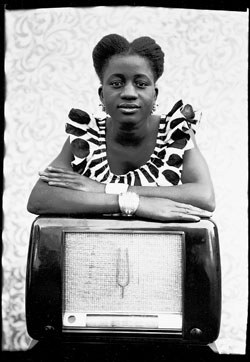"I don't battle anymore! I uplift motherfuckers!" - GZA
Monday, February 20, 2006,10:35 AM
Modernity and tradition entwined in a complex dialogue

by Leslie Camhi
Royal Portraits
What was it like to step before Seydou Keïta camera in Bamako, Mali, in the 1950s? If you were a woman, you might have donned your best flowered boubou (the wide-sleeved, flowing robe adapted to both sexes) and elaborately bejeweled your hair, thrown ropes of carnelian beads around your neck and gamely tied your headscarf à la Versailles, before setting out, either alone or with family, for the famous photographer's studio, situated at the bustling crossroads of modernity, near the city's train station, market, and cinema.
While you waited (for the lines could be long), you might, if you were a man, consider changing into one of three Western-style suits Keïta kept on hand to burnish his clients' image with a sheen of wealth and sophistication. Man or woman, you might strap on a wristwatch for perhaps the first time in your life and contemplate posing beside a radio or holding an artificial flower.
When your turn came, the slim, elegant photographer, with his intense eyes and lighthearted manner, did his best to banish any lingering suspicions—the rumor, for example, that someone possessing your picture could revive your unwilling spirit after your death. He seemed to know exactly which gestures would put you and your family at ease and make you look your best, lending your mother-in-law's tribal formality a touch of unexpected nonchalance, throwing your fine shoulders and your sister's impossibly slender fingers into high relief. A lacy bedspread or riotously patterned fabric hung in the courtyard against a mud wall; you stood, sat, or reclined before it, and with one click of the shutter, proudly proclaimed your hybrid allegiance to both the complex, colonially inflected traditions of the Sahel and the latest chic.
Royalty is currently residing amid the fumes from the truck repair shops on West 29th Street, where an exhibition of posthumous prints drawn from Keïta's estate is at Sean Kelly Gallery. Keïta who was born in Bamako around 1923, apprenticed in his father's carpentry workshop and discovered photography at age 12, when an uncle returning from a trip to Senegal brought him a small box camera.
He set up his own atelier in 1948, taking pictures outdoors when he couldn't afford lights. Working under French colonial rule, he photographed the notables of his native city—its women, in particular, as if they were queens, their vivid self-fashioning and embrace of modernity at one with the country's growing thirst for autonomy.
Mali joined the great wave of African independence in 1960. Under pressure from the fledgling socialist government, Keïta closed his portrait studio and went to work as an official state photographer. But he carefully preserved some 7,000 negatives from its heyday. In 1992, visitors from the West discovered this trove of images embodying the promise of a newborn society and its dawning self-consciousness—precious documents of a rare humanity.
The art world lapped them up. Promoted by French curator Andre Magnin and collector Jean Pigozzi, new Keïta prints (vastly enlarged from their original, dimensions) were shown internationally. In 2001, Keïta broke with Magnin and Pigozzi, demanding the return of 921 negatives in Magnin's hands and setting up a foundation with Parisian gallerist Jean-Marc Petras to look after his legacy. (Legal proceedings are pending in France for the return of the now possibly endangered negatives, which represent the photographer's best-known and some of his most brilliant images.) Keïta died later that year, two weeks before the opening of a show Petras had organized at Sean Kell.
The current exhibition confirms the remarkable depth of Keïta achievement. It also suggests just how much work is still to be done by scholars. In the extraordinary ornamental details of their dress and in their comportment, his Bamakois send out a wealth of psychological and political signals that, to the unenlightened viewer, remain both opaque and intriguing, hinting at familial relationships (such as "co-wives," the multiple spouses of a Muslim man) that are not part of everyday life in the West.
The portraits show modernity and tradition entwined in a complex dialogue with no beginning or end. The ghost of Marie Antoinette hovers over the pleated bodices and ruffled blouses of these gay and pensive beauties, some made of "Dutch wax" fabrics imitating colonial Indonesian designs, which were printed in Manchester for export to Africa. Their "aeroplane wing sleeves" and "coat hanger braids" (as the Bamakois called them) turn up in the breeze; they bear the marks of scarification and of Western affluence with equal pride.
Above all, they live. "My wish is that my negatives will survive for a very long time," Keïta remarked in a late interview. "It is true, my negatives breathe like you and me."